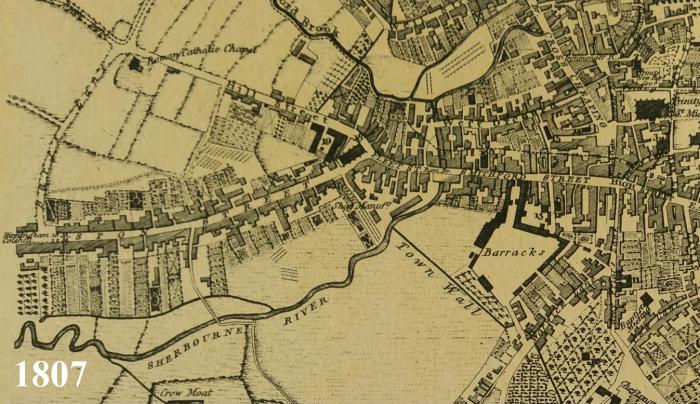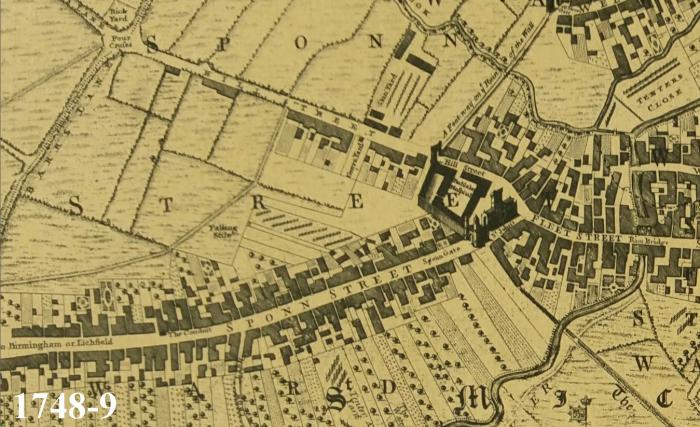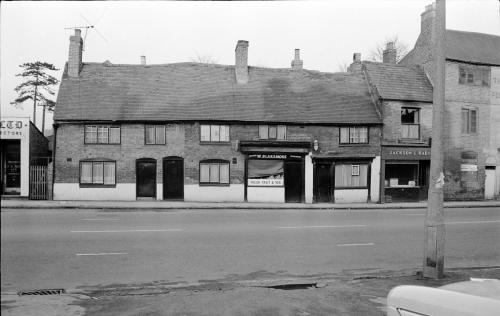|
PhiliPamInCoventry
Holbrooks |
106 of 254
Tue 17th Nov 2015 9:45pm
Hi Anne, Helen & Dutchman |
| Coventry Suburbs and Beyond - Spon End | |
|
sancerre
New Zealand |
107 of 254
Sun 2nd Oct 2016 6:26am
I am looking at Coventry in the late 18th to early 19th Century. I can't figure out where Spon Street started and where Spon End was in relation to it? The old maps of Coventry I have looked at, Spon End seems to be perhaps where Fleet Street is. Can anyone please clarify this for me?
I am researching my family history, and I have a 'The Oath of a Freeman' document dated 1783, my relative living in Spon Street, Worsted Weaver. Unfortunately he has the very common name of William Smith, and during my research I have found a William Smith living in Spon End. Thanks. |
| Coventry Suburbs and Beyond - Spon End | |
|
NeilsYard
Coventry |
108 of 254
Sun 2nd Oct 2016 6:33am
Hi sancerre |
| Coventry Suburbs and Beyond - Spon End | |
|
Helen F
Warrington |
109 of 254
Sun 2nd Oct 2016 10:00am
Hi Sancerre
Yes, Spon Street ran from Conduit Yard and the west end of St John's church (where the original wall ran) to Spon End Bridge (road not rail). From there to Hearsall Lane it was Spon End. As NeilsYard writes, after that there was mostly fields until some time after 1850. One of the reasons the city didn't expand was because the Freemen of the city refused to give up their winter grazing rights to the land around the original layout. It meant the city became very cramped and what had been back gardens became the very grotty courts that most people lived in.
Numbering of houses at that time was consecutive not odds and evens. The courts were eventually numbered but at the time you're looking at they were named after the business or house that served as the street entrance. The passageway to them was originally the front and back doors of a medieval house that by the 18th century had been split up into 2 or 3 different units. Most original Spon Street buildings were 2 storey and many survived until the war. Of the few that were 3 storey, some were modified 2 storey structures, often just putting a flatter, slate roof in a set of attic rooms. Spon Street had a fair amount of traveller accommodation/pubs. These seem to have been rebuilt with brick 3 storey properties. The courts were newer, built of brick and often 3 storey. Weavers often used the upper floor to house their loom, not least because the light was better. You'll see slightly industrial windows at that level compared to the rest of the house. They were called top shops.
Surviving weaver's house in Spon Street
Top shops
Weavers in Coventry
Coventry Worsted weavers |
| Coventry Suburbs and Beyond - Spon End | |
|
Slim
Another Coventry kid |
110 of 254
Sun 2nd Oct 2016 11:28am
On 20th Oct 2015 11:38am, AD said:
That reminds me of the bridge, but viewed from the other, i.e. Allesley, side, and an incident in the late 50s, or early 60s. The chief constable was Edward Pendleton, a big bloke who lived near my parents' shop, and was a regular customer. He had publicly stated that the police force needed more officers whose roots lay outside this country, as the immigrant population was growing, to harmonise relationships. This incensed many people, and overnight, large scurrilous white letters had been painted across the brickwork of the bridge, for all to see. It must have taken ages, probably the work of several people, and they must have risked their lives by dangling over the edge with paint and brush. The picture was on the front page of the CET; I daresay they couldn't print it now. The words read "PENDLETON THE JEW WANTS ****** POLICE DO YOU?" I can't remember the culprit/s being caught, but the offending letters were swiftly painted over in paint which matched the colour of the bricks. I don't go that way these days, but I would not be surprised if the painted squares are still there.
Whilst on the subject of Spon End, does anyone remember a very old dilapidated run-down Tv repair shop called Jackson's Radio? The chap who ran it was a one-off, a middle aged man in a tweed jacket who lived with his elderly mother above the shop (most likely in squalor). The shop was by the post office, near Ray Bennett's motor-bike shop. The inside was dingy, maroon and white-gone-cream-gone yuk colour, it had not been decorated or cleaned in decades, and was sticky with the tarry residue of cigars. Yes, the bloke permanently had a lighted cigar in his mouth. The shop stank, mainly of cigar... maybe something else, I was informed many years later by a contractor whose business converted the terrace of properties into residentrial accommodation. But I don't want to put any of our readers off their breakfast! On 20th Oct 2015 1:42am, NeilsYard said:
Apologies of this is a repost but linking this in to the images up towards the Plaza.
I don't know if it's just me but does the road seem a lot wider in that photo, stretching between two of the arches rather than one?
Seems odd that in days gone by the road was wider but now, with bigger cars and vehicles, and more of them, plus this road being joined to a multi-lane bypass that it appears to have got smaller.

|
| Coventry Suburbs and Beyond - Spon End | |
|
dutchman
Spon End |
111 of 254
Sun 2nd Oct 2016 1:57pm
Yes he died and the shop became Elizabeth Jackson (hairdresser). The hairdresser's window display included an empty television cabinet decorated with starfish and seashells which baffled me at the time.
|
| Coventry Suburbs and Beyond - Spon End | |
|
MisterD-Di
Sutton Coldfield |
112 of 254
Sun 2nd Oct 2016 2:41pm
You are spot on, Slim. That's exactly what it said. In fact, I posted this on another thread last year:
"That article refers to one of the country's first ethnic minority policemen. There was a lot of opposition in Coventry to his appointment and there was some fairly prominent graffiti painted on the railway bridge in Spon End. It was rapidly painted over but it remains to this day and can be seen from the Melbourne Road side. If you knew what it said you can still make it out almost 50 years later, even on Google Maps!"
The only point I would make is that the paint certainly didn't match the bricks, it was white. It's rather faded now, with some greenery growing along the bridge, but you can still match the squares up with what was daubed there.
|
| Coventry Suburbs and Beyond - Spon End | |
|
NeilsYard
Coventry |
113 of 254
Sun 2nd Oct 2016 9:02pm
Wow I never knew that - Slim/Mister D are right!  |
| Coventry Suburbs and Beyond - Spon End | |
|
sancerre
New Zealand |
114 of 254
Mon 3rd Oct 2016 6:27am
On 2nd Oct 2016 6:33am, NeilsYard said:
Hi sancerre
Thanks very much, I have spent some time today looking at old maps and reading up. I can now see that Spon End was on the outskirts of the city, and Spon Street leading immediately up to Spon Gate. I have a lot more reading to do! |
| Coventry Suburbs and Beyond - Spon End | |
|
sancerre
New Zealand |
115 of 254
Mon 3rd Oct 2016 6:39am
Thanks for that info Helen, and for the links which look very interesting. That is very interesting re the houses being named after the business. The Weaver's son got an apprenticeship as a Watchmaker in 1811, he was a 'child of Mr Fairfax's Charity School'. The Watchmaker next appears in Clerkenwell in about 1828. They appear to have been dissenters and it is quite a trail to follow, especially when the place names are unfamiliar - I live in New Zealand.
|
| Coventry Suburbs and Beyond - Spon End | |
|
Slim
Another Coventry kid |
116 of 254
Mon 3rd Oct 2016 7:37am
On 2nd Oct 2016 1:57pm, dutchman said:
Yes he died and the shop became Elizabeth Jackson (hairdresser). The hairdresser's window display included an empty television cabinet decorated with starfish and seashells which baffled me at the time.
That's interesting, Dutchman, now that you remind me of it, for many years the shop window had displayed merely an old cathode ray tube (the old type tv tube, prior to flat screens), with stick-on white letters on the screen, reading TV REPAIRS or something, I cannot say exactly. The tube had been removed from a television from the 50s era, so it was an old black and white one. I wonder if the empty tv cabinet you refer to was the one from which the tube had been removed? I got the impression that the rear of the premises was a tip of old scrap tellys and bits, valves etc., and that nothing was ever thrown away.
I wonder if Elizabeth Jackson was his sister? I got the impression Harold had never married. The more I think bout it, the more I think it unlikely that he was the marrying kind, in a manner of speaking.
|
| Coventry Suburbs and Beyond - Spon End | |
|
Slim
Another Coventry kid |
117 of 254
Mon 3rd Oct 2016 7:42am
On 2nd Oct 2016 2:41pm, MisterD-Di said:
The only point I would make is that the paint certainly didn't match the bricks, it was white. It's rather faded now, with some greenery growing along the bridge, but you can still match the squares up with what was daubed there.
My memory is also fading, Mr D-Di. I guess the council had to take immediate action, and didn't have time to obtain paint that was an exact match!
|
| Coventry Suburbs and Beyond - Spon End | |
|
Slim
Another Coventry kid |
118 of 254
Mon 3rd Oct 2016 7:57am
My mother was born in 1921, to a very poor family. Her father was a bricklayer, my mum's mum having died after giving birth. The whole area was looked down on by people from just over the road a bit, Broomfield Road, in other words Earlsdon, like my dad's family, who thought my dad was courting someone form beneath his class. I guess it was a case of upper working class and lower working class.
The Spon End gang used to sneer with comments like "brown boots and no breakfast", "casement curtains and no food in your belly", and suchlike. One Sunday afternoon, they confronted my dad and his pals kicking a ball around on Hearsall common. The big guy, the leader, said he was going to teach them a lesson and picked on my dad's elder brother first, thinking he was the weedy one as he had always worn glasses since a toddler. What he didn't know was that Uncle Bill was not academically inclined, and was prone to using his fists first, then thinking afterwards. Yes, he was the scrapper of the family, like my granddad, and did boxing. He decked the leader and the gang fled, never to give any more bother. So the story went!
Mum lived in one of the courts as a young girl (don't know the number), and she said not only was there no heating in the house, there was no bathroom - a tin bath hung on the outside wall, and was brought in front of the fire in the living room, and had to be filled with several kettles of boiling water. |
| Coventry Suburbs and Beyond - Spon End | |
|
heathite
Coventry |
119 of 254
Mon 3rd Oct 2016 8:00am
Hi, a couple of older maps. I hope this helps.


|
| Coventry Suburbs and Beyond - Spon End | |
|
dutchman
Spon End |
120 of 254
Mon 3rd Oct 2016 2:22pm
On 3rd Oct 2016 7:37am, Slim said:
That's interesting, Dutchman, now that you remind me of it, for many years the shop window had displayed merely an old cathode ray tube (the old type tv tube, prior to flat screens), with stick-on white letters on the screen, reading TV REPAIRS or something, I cannot say exactly. The tube had been removed from a television from the 50s era, so it was an old black and white one. I wonder if the empty tv cabinet you refer to was the one from which the tube had been removed?
That sounds exactly like it Slim 
|
| Coventry Suburbs and Beyond - Spon End | |
Website & counter by Rob Orland © 2024
Load time: 650ms